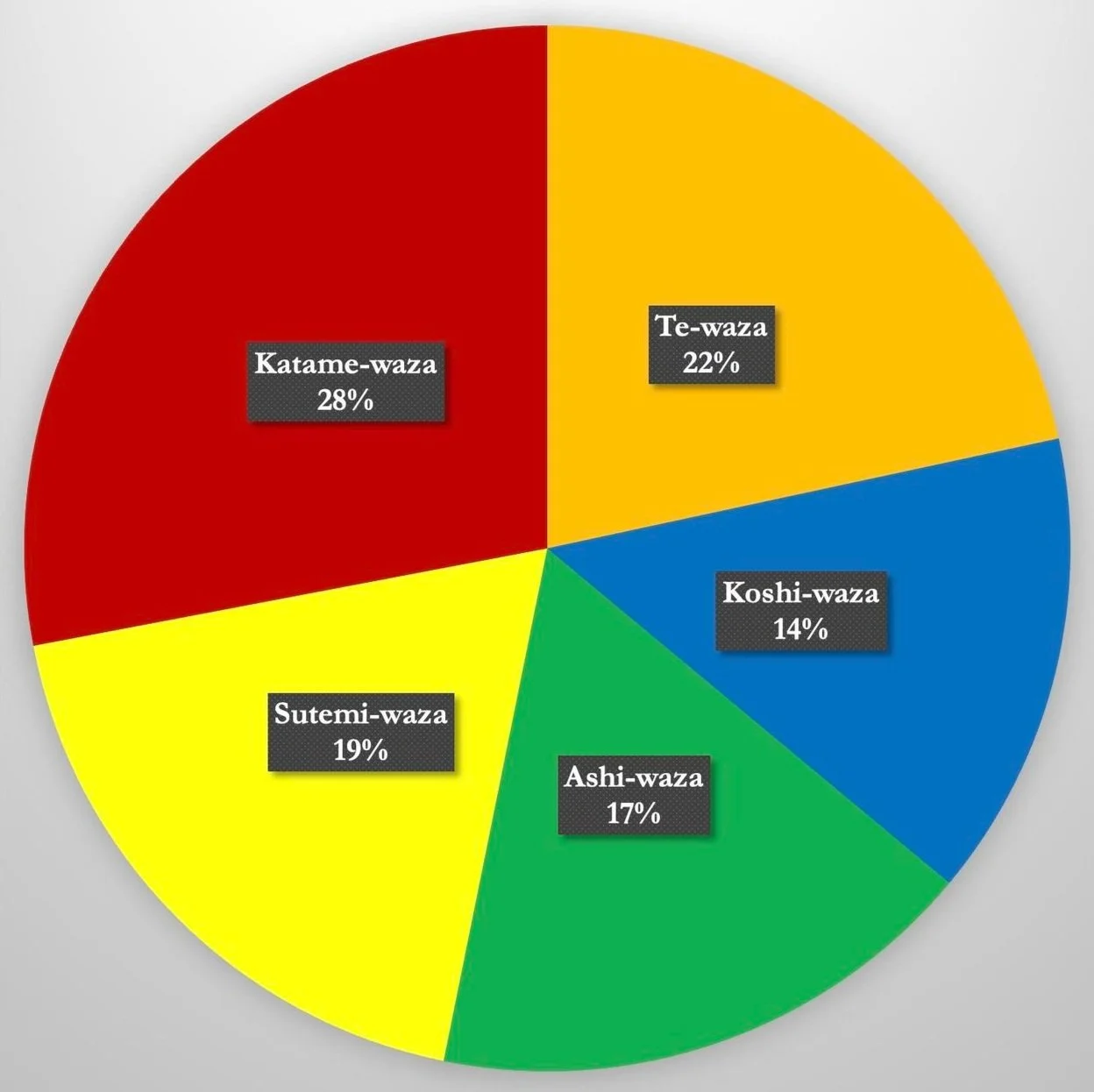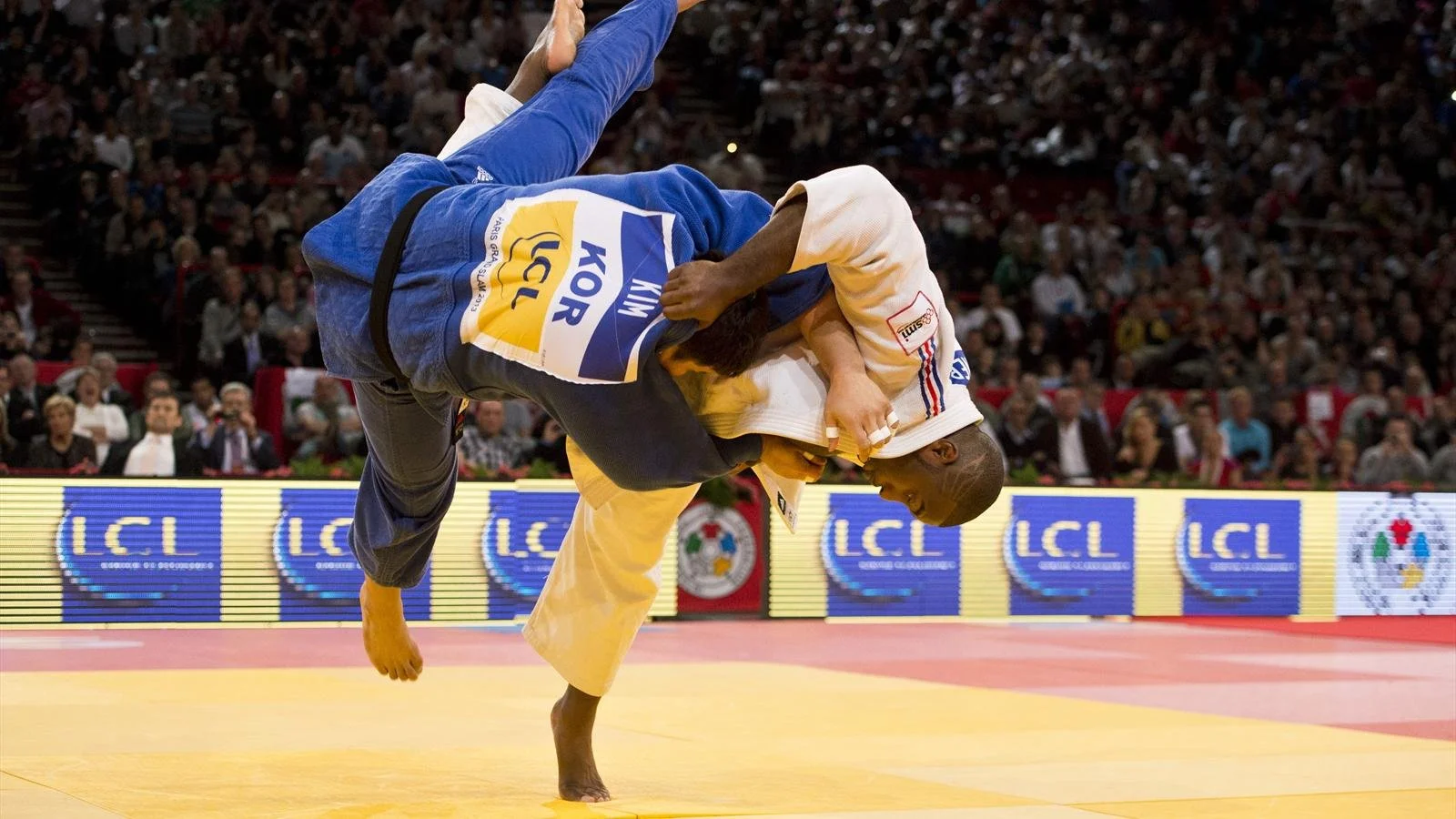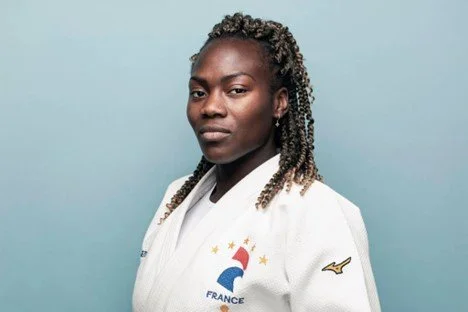Four New Yellow Belts Following First Fundamentals Class Promotion
From Left to Right - Rachel Salisbury, Kellen Zander, Joseph Lily, Joseph Swedenhjelm, Sensei Chaye Thompson
Judo is brutal to the ego particularly of those who begin as adults, for several reasons. Earlier this year the Des Moines Judo Academy added its fundamentals class in an effort to make taking up the study of judo easier for those who only began to study the art later in life. Focused primarily on the needs of newer judoka, while offering more advanced students an opportunity to refine their technique or learn moves to which they had not previously been exposed, this project, helmed by Sensei Chaye Thompson, has steadily grown from one or two students on a single evening to numerous students spread across two sessions per week. On November 5th, 2025, the programs experienced further success when its inaugural group of white belt attendees were promoted to rokkyu, receiving their yellow belts, just in time for the Iowa State Championship.
The group promoted consist of Joseph Swedenhjelm, Joseph Lily, Kellen Zanders, and Rachel Salisbury.
Joseph Swedenhjelm (“Joe Swede” or “Swede” for short) a married father and former wrestler, is rapidly adapting his wrestling training to the gentle way, often grasping variations on moves he’s familiar with from his prior training after only a short demonstration. While Swede excels at O-Goshi, he has cultivated an enviable Ko-Uchi-Gari to O-Soto-Gari renraku-waza or combination that has won him a lot of success in randori. Since his promotion, Swede has made his debut in competition at the Iowa State Championship, and has been, when time allows, working on a tournament legal version of Kata-Guruma or “Fireman’s Carry.” Swede is a quiet man with subtle expressions, more likely to make his feelings known through the flash of a smile or fleeting expression than via words. However, once you learn to read him, a deep and broad sense of humor is quickly revealed.
By contrast Joseph Lily (“Joe Lily” or just “Lily”) comes from no grappling background, with his first venture into martial arts appearing to be judo. Despite this, Lily is often paired with Swede for drills and training due to their similar size. Lily is the more vocal of the quiet duo, with a dry sense of humor. Lily, who has an interest in becoming a police officer like several member of the Des Moines Judo Academy, expresses little interest in competition, instead being focused on personal growth. Lily has a penchant for Seoi-Nage, commonly called a “shoulder throw.”
Kellen Zanders studies bjj and karate in addition to Judo, as well as dance. The active man typically attends only one class a week, and has made substantial strides in doing so. Judo training has improved Kellen’s performance in all his physical studies by giving him a better understanding of the interactions between his own body and that of his opponent. This has translated to better rolls while at bjj and more effective practice at karate. Typically seen smiling with short interruptions for burst of laughter, prior to promotion Kellen’s initial preferred technique was Seoi-Nage. Since his promotion, Kellen has recently discovered that has some natural talent at O-Goshi, which this writer feels may develop into a general preference for koshi-waza.
Rachel Salisbury rounds out the initial promotion group. This is Rachel’s second round on the mat, having initially engaged in training for approximately two months around a year ago. Rachel’s initial interest in Judo was piqued when she observed a tournament in December of 2023. Since returning to the mat earlier this year, Rachel finally participated in competition herself in Minnesota, taking bronze and igniting a passion for competition. In addition to fundamentals class, Rachel frequently attends 5:30 PM judo classes on Monday and Wednesday, Thursday class, Friday and Saturday open mats, and open mat at our sister-school Grinnell BJJ. As a result of this serious grind mentality, Rachel has developed a significant amount of skill in a limited time, but is also typically less than fully recovered at any point in time. Rachel is adept at drop Morote-Seoi-Nage, or drop “two handed shoulder throw”, Sasae-Tsurikomi-Ashi, and De-Ashi-Barai (Advanced foot sweep). She also demonstrates a skill at ude garami (kimura version to BJJ people) from guard when on the ground.
Congratulations to all the newly minted yellow belts, and may their futures have much success!
Mastering the High-Percentage Throws for Ippon: Stats from the Best Judoka
Judo is all about timing, technique, and precision. While there are dozens of throws to learn, certain throws consistently lead to Ippon (the perfect throw), which ends the match. But which throws have the highest success rates, and what sets the world’s best Judoka apart in their ability to execute these throws? Let’s dive into the stats behind high-percentage throws and take a look at some of the top Judo players and the techniques that help them dominate on the mat.
What Makes a Throw High-Percentage for Ippon?
In Judo, Ippon is the ultimate goal of any throw. It’s awarded when a competitor successfully throws their opponent onto their back with force, speed, and control. However, not all throws are created equal. Some throws have a higher success rate due to their ability to off-balance the opponent quickly and forcefully.
High-percentage throws for Ippon tend to share a few common features:
Strong kuzushi (off-balancing): Creating a strong imbalance is the first step in setting up any successful throw.
Proper timing: Knowing when to execute the throw is critical. The best Judoka can sense the exact moment to attack.
Adaptability: Being able to switch between different throws depending on the opponent’s movement and reactions.
Top Judo Players and Their High-Percentage Ippon Throws
The world’s best Judoka have refined certain throws that they’ve used to earn consistent victories. Let’s take a look at some of the top players in Judo and their high-percentage throws for Ippon.
1. Teddy Riner (France) – Uchi Mata (Inner Thigh Throw)
Teddy Riner, one of the most decorated Judo players in history, has won numerous World Championship titles and Olympic gold medals. His signature move is the Uchi Mata (inner thigh throw).
Throw Breakdown: Riner uses his massive size and incredible control to execute a flawless Uchi Mata, where he sweeps his opponent’s leg while simultaneously lifting them with his body. Riner’s ability to maintain perfect kuzushi while using his strength and leverage makes this throw one of his highest-percentage techniques.
Success Rate: Uchi Mata is one of the highest-scoring throws in his repertoire, delivering Ippon with great consistency due to his ability to get his opponent’s leg off the ground and control their movement.
Teddy Riner performs a perfect Uchi-Mata
2. Shohei Ono (Japan) – Seoi Nage (Back Carry Throw)
Shohei Ono is known for his Seoi Nage, one of the most successful throws in Judo. His technique has helped him win multiple World Championships and Olympic gold.
Throw Breakdown: Seoi Nage is a shoulder throw where the Judoka uses their hip and shoulder to lift the opponent onto their back, creating a clean Ippon. Ono’s success lies in his flawless timing, quick entry into the throw, and precision in lifting and throwing his opponent.
Success Rate: Ono has a high success rate with Seoi Nage, particularly when he enters the throw while his opponent is off-balance or attacking. His ability to land Ippon with this throw makes it his go-to technique in major competitions.
Shohei Ono performing O-Soto-Gari (for some reason) using an armpit grip.
3. Clarisse Agbegnenou (France) – Uchi Mata (Inner Thigh Throw)
Clarisse Agbegnenou is a dominant force in the women’s Judo world and has earned multiple World Championship titles. Like Riner, she excels with Uchi Mata, using it to secure many of her wins.
Throw Breakdown: Agbegnenou’s Uchi Mata is characterized by precise movement and exceptional timing. She utilizes her footwork and kuzushi to set up the leg sweep with devastating effectiveness. By lifting her opponent’s leg and guiding them over her, she secures Ippon with smooth control.
Success Rate: Uchi Mata is a key element of Agbegnenou’s strategy and results in frequent Ippon victories. She’s one of the most successful women in Judo with this move, frequently using it to dominate her opponents.
Clarisse Agbegnenou using expression based Kusushi
4. Ryu Shichinohe (Japan) – Tomoe Nage (Circle Throw)
Ryu Shichinohe, a competitor from Japan, is known for his creative and effective use of Tomoe Nage (circle throw), a throw that isn’t seen as often in modern Judo, but when executed correctly, it’s a powerful weapon.
Throw Breakdown: Tomoe Nage involves the Judoka using their body to create a circular motion, pulling their opponent over their head and onto their back. Shichinohe’s timing and positioning make him especially dangerous with this throw, as he can surprise opponents with quick and fluid movements.
Success Rate: Shichinohe’s ability to land Ippon with Tomoe Nage is impressive, especially given how unexpected the move is for opponents. This throw isn’t as commonly used at the highest levels but has been incredibly successful for him when executed at the right time.
5. Naohisa Takato (Japan) – Ashi Waza (Foot Techniques)
Naohisa Takato has made his mark in the Judo world with his Ashi Waza (foot techniques), particularly his Kouchi Gari (small inner reap) and De Ashi Barai (advancing foot sweep).
Throw Breakdown: Takato is known for his lightning-fast footwork. He uses Ashi Waza to attack his opponent’s legs, off-balancing them quickly and sweeping them off their feet with precision. His De Ashi Barai is a signature move that takes advantage of his opponent’s step forward to swiftly sweep their foot.
Success Rate: Takato’s foot sweeps result in high rates of Ippon. He is quick, agile, and precise, making him a dangerous competitor when it comes to Ashi Waza.
Naohisa Takato being goofy.
The High-Percentage Throws: Why Timing Matters
While the above Judoka have their favorite, high-success throws, the real secret to their success lies in timing. Ippon isn’t about just throwing an opponent, it’s about throwing them at the right moment. These high-percentage throws work because the Tori takes advantage of the opponent’s off-balance position and seizes the opportunity to execute the throw.
The success of a throw depends on:
Kuzushi (off-balancing): You need to get your opponent’s weight onto the leg or position that is vulnerable to your attack.
Timing: Knowing when your opponent is most vulnerable to a throw and reacting instantly.
Commitment: Once you’ve set up the throw, committing to it fully is key to executing it successfully.
The Takeaway: Mastering High-Percentage Throws
While there are many throws to master in Judo, certain throws consistently produce high rates of Ippon. Judoka like Teddy Riner, Shohei Ono, and Clarisse Agbegnenou have made their names with certain signature techniques that they’ve perfected through practice, timing, and precision.
For beginners and seasoned competitors alike, focusing on mastering these high-percentage throws can give you an edge in competition. Whether it’s Uchi Mata, Seoi Nage, or Ashi Waza, these techniques have been proven to work time and time again at the highest levels of Judo.
So, the next time you hit the mat, remember that mastering these high-percentage throws could be the key to landing that Ippon and taking your Judo to the next level.
Your Turn:
What are your high-percentage throws? Why do you use them, and how do they work best for you? Also, who is your Judo hero or inspiration? Let’s hear who motivates you and what throws you’ve mastered from their playbook. Share your thoughts in the comments below!
Brown Belt Sneaks in Surprise Promotion Mid-Celebration
On Monday, December 30th, 2024, amid the fanfare surrounding Ryan Hanssen’s promotion to “Shodan” or blackbelt a smaller, but no less significant, promotion was issued.
John Long, the man who served as “uke” (the person upon whom a technique is performed; the fancy way of saying living throwing dummy) for the Nage-no-Kata (the performance of a pre-arranged sequence of techniques to demonstrate technical proficiency), was promoted from “Sankyu,” the first rank of brown belt, to “Nikyu,” the second rank of brown belt. Serving as uke for kata is one method of earning a promotion, as doing so properly demonstrates competence, if not mastery of several fundamental skills for any “judoka” (judo practitioner), most particularly “ukemi” (the skill of falling without harm or injury). Serving as uke for any kata requires extensive training prior to even undertake the weeks of practice necessary. It is also a substantial time commitment, as most judo kata are interactive, meaning the “tori” (person performing the technique) cannot practice without the uke being present.
John is an active and competitive judoka, maintaining a an extremely fit physique, in contrast to his laid back and easy going attitude. Outside of judo, he enjoys travel, often spending weeks at a time in Asia, craft beer, comedy shows, and somehow finding time to fit in anime and videogames. On the mat, John is known at the Des Moines Judo & Sambo Academy for his powerful “uchi-mata” or “inner thigh throw,” which can be described as both elegant and text book. Of late, he has been diversifying his arsenal by working on his “seoi-nage” (shoulder throw), and has recently been noticed dropping white belts with foot sweeps.
Mr. Long’s well earned promotion leaves only “Ikkyu,” the final brown belt rank, between him and a blackbelt.
(John is show wearing his brown belt in the associated picture, which is from when he received his Sankyu in April. This is because it appears John snuck out on Monday without getting his picture take. Bad John, old picture for you!)
Great Performance at 2024 Iowa State Championship
Des Moines Judo & Sambo Academy had seven Judoka compete at the 2024 Iowa State Championship, hosted at Teikiatsu Judo in Ames, Iowa, on November 9th, with several wounded members making an appearance to coach and support.
Junior competitors Brayden and Jayce Hanssen each earned silver in their respective divisions after obtaining a win each. Senior women’s medium competitor Olivia McBee also took silver in her division. Josh Pohl, the regular instructor for Thursday evenings, took to mat to claim gold in his division, winning both matches by throw for Ippon. Upon winning his first match via his well honed drop seoi-nage, some crowd member was heard to exclaim “it’s funny when it happens to someone else!” between burst of riotous laughter. Recently joined white belt, but long time wrestler, Christian Wilson was able to claim gold after stepping onto the tatami for the first time and looks to have a strong future in his new found passion.
Lastly, the long standing rivalry between training partners and close friends (some say too close) Logan Ballanger and Jacob van Cleaf had an unexpected upset, with Jacob claiming his first two victories on the competition mat, and the Masters Heavy weight gold medal over Logan. Ballanger found some measure of revenge in the Senior 220+lbs division, claiming victory by pin with Kesa Gatame.








